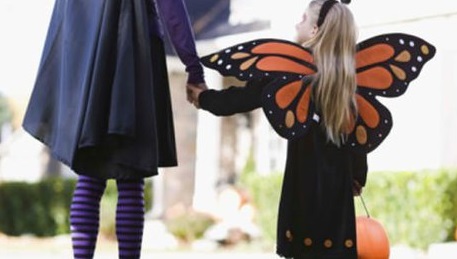Halloween parties, costumes, make-up, masks, trick-or-treating, and treats. This all sounds like fun to many children, but Halloween “fun” can be a sensory nightmare for children with sensory issues. Fortunately, there are ways to help make Halloween more enjoyable for the child who struggles with sensory issues.
SPD For Halloween Tip 1 – Exposure to Halloween early and often
Start early in explaining Halloween to your children to ensure a successful night. Repetition helps kids with sensory processing difficulties understand an event or holiday.
SPD For Halloween Tip 2 – Pick the right costume
- Choose a non-scary costume
- Let your child help select a costume. A bumblebee suit with wings and bobbing antennae may be too much to handle, but a silly shirt or a handheld prop might be perfect.
- Try out the costumes, make sure they are a good fit.
- Practice walking and sitting while wearing the costume.
- Wearing a mask may be uncomfortable. He may prefer to hold the mask or just skip it.
- If costumed, make sure it’s something she can partially or fully remove so she doesn’t have to go home if she becomes uncomfortable.
- If your child is not wearing a costume, make sure they know there is nothing wrong with them.
- If your child is afraid of trick-or-treating and seeing others dressed up in costumes, stay home and hand out candy from the front yard or the doorway.
- Your child can wear his costume in safe and familiar environments such as the neighbors’ and relatives’ houses.
- Never force your child to wear a costume. If they do not want to wear one at all, that’s okay!
- Experiment with face make-up as tactile exploration. However, bring baby wipes to remove it just in case.
SPD For Halloween Tip 3 – Avoid Scary Games and Activities
- Explain in advance what to expect at parties.
- Halloween games are as popular as trick or treating, but games like bobbing for apples or swinging the apple on the stick can be difficult for kids with SPD to understand, and can be dangerous.
- For games in the classroom, always talk to your child’s teacher to determine appropriateness.
- It’s always best to practice games at home before trying them at school or at a party.
- Don’t pressure your child to participate.
- Pumpkin carving and face painting can be daunting.
- At a party, identify a “safe spot” to take breaks if needed to avoid sensory overload.
- Bring a comfort object or a hand fidget for needed calming input.
SPD For Halloween Tip 4 – Try a New Tradition
Did you know the act of knocking on doors and tricking-or-treating is actually on the decline? Many people are trying new traditions, such as private parties where parents can control the environment and the type of candy and food their child receives.
SPD For Halloween Tip 5 – Do a Trial Run for Trick or Treating
- If you want your child to experience trick-or-treating first-hand, remember that practice really does make perfect. Repetition of the trick-or-treating route will make it easier for your child to grasp the act.
- Remember, the quality of your child’s experience is more important than how many houses you visit. Stick with the familiar and head to houses your child knows.
- Start trick-or-treating early, before it gets dark
- Be sensory smart when trick-or-treating; stay away from crowds
- Eat and hit the bathroom before you go out
- Have a buddy for you and your child
- Know when to call it a night before things get overwhelming
- Have your child open the door for trick-or-treaters, especially if they did not do well getting the candy.
This article was published by North Shore Pediatric Therapy
